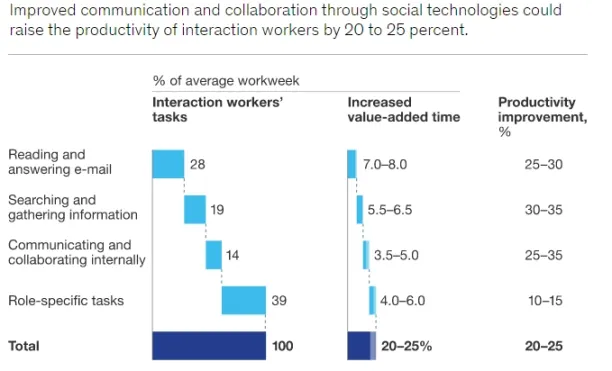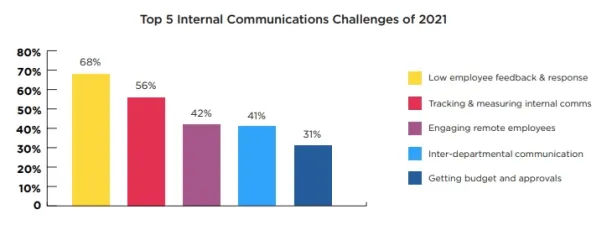Internal Communication Strategies: Tools & Best Practices in '24
Internal communications strategies affect organizations’ daily operations. For example, effective employee communication creates a better working environment for everyone. Employees can continuously get information about the company strategies and goals and provide their feedback. It can increase employee engagement and better-engaged employees can increase companies’ operating income by 19.2% over a year.
What is internal communication?
Internal communication is the way people within an organization communicate and connect with each other. It can happen through various channels such as emails, employee intranet, and team meetings.
Why is internal communication important?
Increases employee engagement and productivity
According to a McKinsey Global Institute report, companies can improve communication and collaboration in the workplace by using social technologies and increase employee productivity by 20 to 25 percent.

Increases employees’ sense of commitment
Regular contact with employees increases their sense of commitment to the company. According to research from Trade Press Services, 85% of employees say their motivation is boosted when management regularly provides regular updates on company news. An internal communication application provides regular communication with employees and helps you pre-schedule your communications.
What are some internal communication tools?
- Instant messaging tools
- allows you to send text messages, photos, videos, or web links
- a more practical way to get information compared to email
- Intranet
- a private network that’s connected via the web and designed as a centralized channel for internal communications
- Video Chat Tool
- Skype, Zoom and PowWowNow are examples of video chat tool
- Email/Newsletter
How to choose the right communication channel for your organization?
- Evaluate your existing internal communication channel by considering the types of messages that your employees will receive. For example, is the information that you will distribute time-sensitive; are the message requires feedback from anyone?
- Evaluate your internal channel options. You need to understand the audience of the message you are sending. Which communication channels do your target audience interact with or prefer? By selecting the most appropriate channel mix for your target audience, you can reduce friction.
- Distribute messages in accordance with the company’s communication culture. For example, if your company has certain working hours, send emails and messages during working hours. According to a research by Salesforce, 86% of employees and executives think that ineffective communication is one of the reasons for workplace failures.
How to measure internal communications?
Choosing the right technology for internal communication is important. However, merely communicating with employees is not enough for effective internal communication. You also need to measure the impact of the internal communication tools you use within the organization. Key performance indicators (KPIs) are used to measure the effectiveness of internal communications.
According to the Global State of Internal Communications 2021 report, 84% of internal communicators find measuring internal communication challenging.

Internal communication metrics
You can collect your data from the internal communication channels such as email, newsletter, and employee apps you use. Decide what quantitative data you can collect from these channels. Common metrics that will help you evaluate the impact of the internal communication tools you use include:
- Reach gives information about how many employees logging in and opening communication channels that you use
- Open/read rates such as opening a newsletter, how many employee opened your newletters, messages etc.
- Engagement rates including responses or comments
Qualitative data is useful as a measurement tool. However, you need to compare your quantitative and qualitative data to see more clearly the impact of your internal communication tools. According to research from Gartner, formal surveys are in decline and 59% of organizations will start using employee engagement data beyond official surveys.
For more, feel free to check our article on top employee communication apps.
If you have more questions, we would like to help:

Comments
Your email address will not be published. All fields are required.